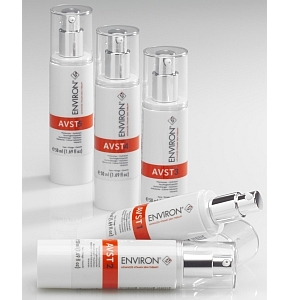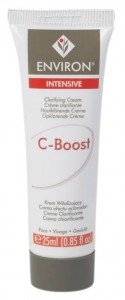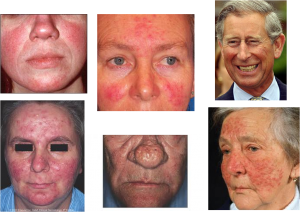This article was written by Dr Des Fernandes who is the founder of the Environ skin care.
Rosacea – the Environ solution by Dr Des Fernandes
‘Rosacea is a chronic skin problem that is not well understood’ and characteristically affects people with pale skins, blue eyes and generally starts in middle age. People with darker skins also get rosacea, but the signs are less florid. It is always associated with redness of the skin, often with small papules (or lumps) which may becomes pustules. It may resemble acne but if you look closely at the skin, you will not see any blackheads. The skin feels uncomfortable and usually the central areas of the face are involved. While this is a chronic disease, in some cases there are periods of remission, and at other times, it is worse. The cheeks are generally cherry red, especially close to the nose – due to telangiectasia (dilated, ‘broken’ blood vessels). Very often, dilated blood vessels are prominent markers, but in general, the pinkness of the skin is due to actinic damage to the underlying microscopic blood vessels. The nose is almost always involved and after many years, may become thickened and misshapen. A potato-nose (called rhinophyma) is always due to this condition.
The cause of rosacea
‘No one knows the exact cause of rosacea at this stage.’
We know that it is aggravated by exposure to the sun, heat, warm drinks and alcohol. Some people have postulated that it is due to an infestation of tiny mites (Demodex folliculorum) in the skin that burrow into the skin’s hair follicles and cause the reaction. The fact that topical metronidazole (a type of antibiotic) has been used with considerable success, makes one believe that this may be an important part of the problem.
‘I believe that we have to consider it from another angle as well:’ all the signs are also typical of photo-damage (sun-damage) to the skin. The central part of the face gets more sun than the sides, and pale-skinned people get more sun damage than darker skinned people. I postulate that an infestation super-imposed on photo-damage is the underlying cause of the problem.
1. Photo-damage would have accumulated into quite a severe state in pale-skinned individuals by middle age – even in colder areas where UV-A damage still occurs.
2. Telangiectasia is also caused by actinic damage. Telangiectasia is mostly likely due to the destruction of the collagen support around the blood vessels and this of course would be the result of chronic photo-degradation of both vitamin A and C.
3. Experience shows that long-term use of a skin-care range containing vitamin A and C with antioxidants, leads to improvement in the rosacea.
The usual treatment for Rosacea
1. Usually patients with rosacea are given topical metronidazole, topical or even oral antibiotics.
2. Tetracyclines are often given but one should be aware that tetracycline aggravates photo-damage.
3. People with severe rosacea are often given retinoic acid and this initially aggravates the condition by making the acne eruption worse and increasing the redness of the skin. However, after prolonged use the skin does improve. Generally the patients stop using the retinoic acid before they can get the improvement. Here one has to bear in mind that retinoic acid is just another version of vitamin A, so we should not depend on retinoic acid for the end result.
‘My preferred way to treat Rosacea.’
If the patient is on metronidazole cream then I ask them to continue using it until the skin has imporved. If they complain that their skin is sensitive to the metronidazole, then I stop it and rely only on the home care, and peeling when necessary.

1. I first explain to the person suffering from Rosacea that we have to address the chronic deficiency of vitamin A in the skin that has been a major contributor to the problem. I explain that it is easier to treat the skin with a retinyl palmitate product (vitamin A), but that the chance eists that the redness may be aggravated and the skin may feel a bit more sensitive for several weeks before it starts to improve. I start them on the lowest dose of retinyl palmitate (Environ Skin Care: AVST 1) and suggest that they should continue to use it for more than one tube if their skin feels sensitive. Gradually increase the levels of vitamin A.
2. Rosacea is an ideal problem to treat with an alpha hydroxy acid cream at the same time as the Vitamin A. I generall ask the patient to use the vitamin A preparation first, and then a mild Alpha hydroxyl acid cream with a pH of about 3.5 to 4.5. Many people will find that if they use an AHA toner, that the skin stings quite considerably. If this is tolerable then they should persist in using it. I suggest using an AHA cream once a day (Environ Skin Care: Alpha Cream Mild or Alpha Gel). As the skin improves, the frequency can be reduced to about three times a week. After a while the AHA may even be stopped.
This will generally be sufficient treatment for mild cases of rosacea, but it may take several months before the skin is comfortable.
‘In more severe or resistant cases I believe we have to use peeling.’
3. The peel I prefer is TCA as a cream either 2.5 or 5% (Environ ACM #1 and #2). Most of the time I use 5% TCA cream and paint it onto the skin and watch carefully to make sure that only mild frosting occurs on the acne spots. This takes about 5 – 10 minutes to develop.
I also use TCA as a gel (Environ’s TCA Pamgel) but here I only use 2.5%. The advantage of this is that one can easily see what is happening and we can recognize frosting at an earlier stage.
The surrounding red areas should not be frosted otherwise the patient will complain of excessive redness of the skin for several days after the peel. I have found that this mild degree of peeling usually arrests the acne eruption quite quickly and I ask the patient to return within a week to see if we need to do another peel. Because the peel is so mild it can be repeated after a week.
Generally I have found that by the third peel even fairly severe cases of rosacea have made a dramatic improvement with less signs of inflammation, less acne eruption and more comfortable skin. I believe that if an infestation of the skin is part of the problem, then peeling destroys the mites and sterilizes the skin.
Although I have a rule that no one should be peeled without first preparing the skin with vitamin A, if I encounter a severe case of rosacea, I will immediately do a peel with TCA or an AHA product. One has to be very careful to make sure that one does not cause too much frosting because the skin is so reactive.

4. Later on, when the skin has improved, one can address the telangiectasia. Topical vitamin C will help to resotre the collagen support around the dilated blood vessels. The best form, at a neutral pH as found with ascorybl tetra-isopalmitate (in the Environ Skin Care C-Boost product) will go a long way to improving the telangiectasia so that only larger blood vessels have to be treated by a general practitioner, dermatologist or plastic surgeon.
‘I have seen many people who have struggled with rosacea for a long time and have used antibiotics without success but have responded within a few months to the regime I have described above.’ I believe the skin care therapist has a major role to play in the treatment of acne rosacea. Even though this may be resistant to medical treatments, many cases can be rapidly improved with a simple home-care regime and very mild peelings.
If the client has already developed rhinophyma, then they should be referred to a plastic surgeon who can first start with heavy peeling of the nose skin and then maybe consider further surgical procedures. However, these people should still be prepared for the surgeon by light peels and home care regime.
If you would like to learn more:
• Email Claire today
• Or call at 21 440 555 or 99 260 743 to book a free consultation with Claire
Claire Morawski is a skin therapist with over 8 years of experience in the industry. She is the owner and therapist at mySkinandCo. Contact mySKiN&CO today to book a skin-analysis consultation to be able to discuss your concerns further with Claire, and to see how Claire can help you achieve a healthy youthful skin.
If you have enjoyed this article and want to read more by Claire Morawski, then subscribe to start receiving articles directly into your inbox.

